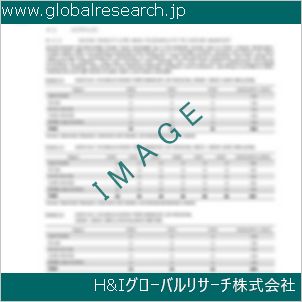Table of Contents
1 Industry Overview of Propineb
1.1 Definition and Specifications of Propineb
1.1.1 Definition of Propineb
1.1.2 Specifications of Propineb
1.2 Classification of Propineb
1.3 Applications of Propineb
1.3.1 Nuclear Application
1.3.2 Non-Nuclear Application
1.4 Industry Chain Structure of Propineb
1.5 Industry Overview and Major Regions Status of Propineb
1.5.1 Industry Overview of Propineb
1.5.2 Global Major Regions Status of Propineb
1.6 Industry Policy Analysis of Propineb
1.7 Industry News Analysis of Propineb
2 Manufacturing Cost Structure Analysis of Propineb
2.1 Raw Material Suppliers and Price Analysis of Propineb
2.2 Equipment Suppliers and Price Analysis of Propineb
2.3 Labor Cost Analysis of Propineb
2.4 Other Costs Analysis of Propineb
2.5 Manufacturing Cost Structure Analysis of Propineb
2.6 Manufacturing Process Analysis of Propineb
3 Technical Data and Manufacturing Plants Analysis of Propineb
3.1 Capacity and Commercial Production Date of Global Propineb Major Manufacturers in 2023
3.2 Manufacturing Plants Distribution of Global Propineb Major Manufacturers in 2023
3.3 R&D Status and Technology Source of Global Propineb Major Manufacturers in 2023
3.4 Raw Materials Sources Analysis of Global Propineb Major Manufacturers in 2023
4 Capacity, Production and Revenue Analysis of Propineb by Regions, Types and Manufacturers
4.1 Global Capacity, Production and Revenue of Propineb by Regions 2019-2024
4.2 Global and Major Regions Capacity, Production, Revenue and Growth Rate of Propineb 2019-2024
4.3 Global Capacity, Production and Revenue of Propineb by Types 2019-2024
4.4 Global Capacity, Production and Revenue of Propineb by Manufacturers 2019-2024
5 Price, Cost, Gross and Gross Margin Analysis of Propineb by Regions, Types and Manufacturers
5.1 Price, Cost, Gross and Gross Margin Analysis of Propineb by Regions 2019-2024
5.2 Price, Cost, Gross and Gross Margin Analysis of Propineb by Types 2019-2024
5.3 Price, Cost, Gross and Gross Margin Analysis of Propineb by Manufacturers 2019-2024
6 Consumption Volume, Consumption Value and Sale Price Analysis of Propineb by Regions, Types and Applications
6.1 Global Consumption Volume and Consumption Value of Propineb by Regions 2019-2024
6.2 Global and Major Regions Consumption Volume, Consumption Value and Growth Rate of Propineb 2019-2024
6.3 Global Consumption Volume and Consumption Value of Propineb by Types 2019-2024
6.4 Global Consumption Volume and Consumption Value of Propineb by Applications 2019-2024
6.5 Sale Price of Propineb by Regions 2019-2024
6.6 Sale Price of Propineb by Types 2019-2024
6.7 Sale Price of Propineb by Applications 2019-2024
6.8 Market Share Analysis of Propineb by Different Sale Price Levels
7 Supply, Import, Export and Consumption Analysis of Propineb
7.1 Supply, Consumption and Gap of Propineb 2019-2024
7.2 Global Capacity, Production, Price, Cost, Revenue, Supply, Import, Export and Consumption of Propineb 2019-2024
7.3 USA Capacity, Production, Price, Cost, Revenue, Supply, Import, Export and Consumption of Propineb 2019-2024
7.4 EU Capacity, Production, Price, Cost, Revenue, Supply, Import, Export and Consumption of Propineb 2019-2024
7.5 China Capacity, Production, Price, Cost, Revenue, Supply, Import, Export and Consumption of Propineb 2019-2024
7.6 Japan Capacity, Production, Price, Cost, Revenue, Supply, Import, Export and Consumption of Propineb 2019-2024
8 Major Manufacturers Analysis of Propineb
8.1 Manufacturer One
8.1.1 Company Profile
8.1.2 Product Picture and Specifications
8.1.2.1 Type I
8.1.2.2 Type II
8.1.2.3 Type III
8.1.3 Capacity, Production, Price, Cost, Gross and Revenue
8.1.4 Contact Information
8.2 Manufacturer Two
8.2.1 Company Profile
8.2.2 Product Picture and Specifications
8.2.2.1 Type I
8.2.2.2 Type II
8.2.2.3 Type III
8.2.3 Capacity, Production, Price, Cost, Gross and Revenue
8.2.4 Contact Information
8.3 Manufacturer Three
8.3.1 Company Profile
8.3.2 Product Picture and Specifications
8.3.2.1 Type I
8.3.2.2 Type II
8.3.2.3 Type III
8.3.3 Capacity, Production, Price, Cost, Gross and Revenue
8.3.4 Contact Information
8.4 Manufacturer Four
8.4.1 Company Profile
8.4.2 Product Picture and Specifications
8.4.2.1 Type I
8.4.2.2 Type II
8.4.2.3 Type III
8.4.3 Capacity, Production, Price, Cost, Gross and Revenue
8.4.4 Contact Information
8.5 Manufacturer Five
8.5.1 Company Profile
8.5.2 Product Picture and Specifications
8.5.2.1 Type I
8.5.2.2 Type II
8.5.2.3 Type III
8.5.3 Capacity, Production, Price, Cost, Gross and Revenue
8.5.4 Contact Information
…
9 Marketing Trader or Distributor Analysis of Propineb
9.1 Marketing Channels Status of Propineb
9.2 Traders or Distributors with Contact Information of Propineb by Regions
9.3 Ex-work Price, Channel Price and End Buyer Price Analysis of Propineb
9.4 Regional Import, Export and Trade Analysis of Propineb
10 Industry Chain Analysis of Propineb
10.1 Upstream Major Raw Materials Suppliers Analysis of Propineb
10.1.1 Major Raw Materials Suppliers with Contact Information Analysis of Propineb
10.1.2 Major Raw Materials Suppliers with Supply Volume Analysis of Propineb by Regions
10.2 Upstream Major Equipment Suppliers Analysis of Propineb
10.2.1 Major Equipment Suppliers with Contact Information Analysis of Propineb
10.2.2 Major Equipment Suppliers with Product Pictures Analysis of Propineb by Regions
10.3 Downstream Major Consumers Analysis of Propineb
10.3.1 Major Consumers with Contact Information Analysis of Propineb
10.3.2 Major Consumers with Consumption Volume Analysis of Propineb by Regions
10.4 Supply Chain Relationship Analysis of Propineb
11 Development Trend of Analysis of Propineb
11.1 Capacity, Production and Revenue Forecast of Propineb by Regions and Types
11.1.1 Global Capacity, Production and Revenue of Propineb by Regions 2024-2029
11.1.2 Global and Major Regions Capacity, Production, Revenue and Growth Rate of Propineb 2024-2029
11.1.3 Global Capacity, Production and Revenue of Propineb by Types 2024-2029
11.2 Consumption Volume and Consumption Value Forecast of Propineb by Regions, Types and Applications
11.2.1 Global Consumption Volume and Consumption Value of Propineb by Regions 2024-2029
11.2.2 Global and Major Regions Consumption Volume, Consumption Value and Growth Rate of Propineb 2024-2029
11.2.3 Global Consumption Volume and Consumption Value of Propineb by Types 2024-2029
11.2.4 Global Consumption Volume and Consumption Value of Propineb by Applications 2024-2029
11.3 Supply, Import, Export and Consumption Forecast of Propineb
11.3.1 Supply, Consumption and Gap of Propineb 2024-2029
11.3.2 Global Capacity, Production, Price, Cost, Revenue, Supply, Import, Export and Consumption of Propineb 2024-2029
11.3.3 USA Capacity, Production, Price, Cost, Revenue, Supply, Import, Export and Consumption of Propineb 2024-2029
11.3.4 EU Capacity, Production, Price, Cost, Revenue, Supply, Import, Export and Consumption of Propineb 2024-2029
11.3.5 China Capacity, Production, Price, Cost, Revenue, Supply, Import, Export and Consumption of Propineb 2024-2029
11.3.6 Japan Capacity, Production, Price, Cost, Revenue, Supply, Import, Export and Consumption of Propineb 2024-2029
12 New Project Investment Feasibility Analysis of Propineb
12.1 New Project SWOT Analysis of Propineb
12.2 New Project Investment Feasibility Analysis of Propineb
13 Conclusion of the Global Propineb (CAS 12071-83-9) Industry 2024 Market Research Report
| ※参考情報 プロピネブ(Propineb)は、カビや真菌に対する防除剤として用いられる農薬の一種です。化学的には、プロピネブはイミダゾール系の化合物に分類されており、その主な用途は農作物の病害防除です。CAS番号は12071-83-9であり、農業において広く利用されている有機化合物の一つです。 プロピネブは特に植物の葉や果実に発生する菌類に対して効果的であり、病害の発生を抑えるために使用されます。そのため、農作物の生産性を向上させるためには欠かせない薬剤といえるでしょう。プロピネブが効果を発揮する代表的な病害には、粉状病や根腐れ病などがあり、これらは農作物にとって非常に深刻な脅威となります。 ### 特徴 プロピネブは水に溶けやすく、作物への浸透性も高いのが特徴です。適用作物に応じて、使用方法や濃度を調整することができ、広範囲の植物に対して効果的に使用されます。また、プロピネブは比較的低毒性であり、誤って摂取した場合のリスクも低いとされています。しかし、使用にあたっては適切な取り扱いが求められ、指示された濃度を厳守することが重要です。 プロピネブは、他の農薬との混用が可能であるため、統合的な病害管理プログラムの一環として使用することができます。これにより、異なる作用メカニズムを持つ農薬を組み合わせることができ、病害の耐性を低下させることにも寄与します。ただし、混用にあたっては相互作用のリスクにも注意が必要です。 ### 種類 プロピネブにはいくつかの製剤形態があり、粉剤、液剤、エマルション剤など、目的や使用条件に応じて選択されています。これにより、散布の方法や対象とする作物の特性に対して柔軟に対応することが可能です。具体的には、家庭用の小規模農業から、商業的な大規模農業まで、幅広い場面で利用されています。 ### 用途 プロピネブの主な用途は、農作物の病害防除ですが、具体的には野菜類、果樹、穀物など多岐にわたります。例えば、トマトやナス、キュウリなどの野菜においては、葉のカビ病や果実の腐敗を防ぐために使用されます。また、果樹類では、リンゴや梨に対するカビ病防除にも効果があるとされています。 プロピネブは、その使用によって作物の健康状態を維持し、収穫量を向上させることを目的としているため、特に食料生産の安定化に寄与します。 ### 関連技術 プロピネブを使用する際には、適切な施用技術を理解し実行することが重要です。具体的には、散布のタイミング、方法、量によって効果が大きく異なります。例えば、発病の兆候を早期に察知し、適切な時期に散布することで、病害の蔓延を防ぐことができます。また、天候条件にも左右されるため、風が強いときや雨が予想される際には散布を避けることが望ましいです。 さらに、持続可能な農業を実現するためには、プロピネブだけに依存せず、他の農薬や害虫の生態系に配慮した対策も考慮する必要があります。これには、農業生態系のバランスを考慮したローテーション施策や、他の防除方法(例:バイオ農薬、物理的防除など)を併用することが含まれます。 また、最近では、農業のデジタル化が進展しており、プロピネブの効果を最適化するために、スマート農業技術を活用することも重要です。ドローンによる農薬散布や、センサーを用いた作物の健康状態モニタリングなどがその一例であり、これによりより効率的かつ効果的な農作業が実現されるでしょう。 ### 結論 プロピネブは、農業における病害防除の重要な役割を果たしている薬剤です。その特徴や用途、関連技術に関する知識を深め、適切に利用することで、持続可能な農業の実現に寄与することが期待されます。農作物の生産性や品質向上を目指し、今後も積極的な研究開発が行われることが望まれるでしょう。 |
❖ 免責事項 ❖
http://www.globalresearch.jp/disclaimer

-gr.jpg)










